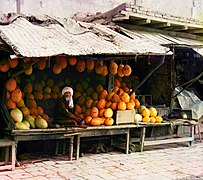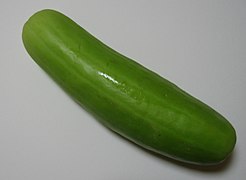Cucumis melo
| Cucumis melo | |
|---|---|

| |
| Scientific classification | |
| Kingdom: | Plantae |
| Clade: | Tracheophytes |
| Clade: | Angiosperms |
| Clade: | Eudicots |
| Clade: | Rosids |
| Order: | Cucurbitales |
| Family: | Cucurbitaceae |
| Genus: | Cucumis |
| Species: | C. melo
|
| Binomial name | |
| Cucumis melo | |
| Synonyms[1] | |
|
List
| |
Cucumis melo,also known asmelon,[2][3]is a species ofCucumisthat has been developed into many cultivated varieties. The fruit is apepo.The flesh is either sweet or bland, with or without a musky aroma, and the rind can be smooth (such ashoneydew), ribbed (such asEuropean cantaloupe), wrinkled (such as casaba melon), or netted (such asmuskmelon). In North America, the sweet-flesh varieties are often collectively calledmuskmelon,including the musky netted-rind varieties and the inodorous smooth-rind varieties,[4]and cantaloupe usually refers to the former type.[5]However, muskmelon in a narrow sense only refers to the musky netted-rind type, also known asNorth American cantaloupe,while the true cantaloupe is the European type with ribbed and often warty rind that is seldom grown in North America.[6]
The origin of melons is not known. Research has revealed that seeds androotstockswere among the goods traded along the caravan routes of the Ancient World. Some botanists consider melons native to the Levant and Egypt, while others place their origin in Iran,[7]India or Central Asia.[8]Still others support an African origin, and in modern times wild melons can still be found in some African countries.[9]
Background[edit]
The melon is anannual,trailing herb.[8]It grows well in subtropical or warm, temperate climates.[9]Melons prefer warm, well-fertilized soil with good drainage that is rich in nutrients,[8]but are vulnerable todowny mildewandanthracnose.Disease risk is reduced bycrop rotationwith non-cucurbitcrops, avoiding crops susceptible to similar diseases as melons.Cross pollinationhas resulted in some varieties developing resistance topowdery mildew.[10]Insects attracted to melons include thecucumber beetle,melon aphid,melonworm mothand thepickleworm.[10]
Genetics[edit]
| NCBIgenome ID | 10697 |
|---|---|
| Ploidy | diploid |
| Genome size | 374.77 Mb |
| Number ofchromosomes | 12 |
| Year of completion | 2012 |
Melons aremonoeciousorandromonoeciousplants.[11]They do not cross withwatermelon,cucumber,pumpkin,orsquash,but varieties within the species intercross frequently.[12] The genome ofCucumis melowas first sequenced in 2012.[13]Some authors treatC. meloas having two subspecies,C. melo agrestisandC. melo melo.Variants within these subspecies fall into groups whose genetics largely agree with their phenotypic traits, such as disease resistance, rind texture, flesh color, and fruit shape. Variants or landraces (some of which were originally classified as species; see the synonyms list to the right) includeC. melovar.acidulus(Mangalore melon),adana,agrestis(wild melon),ameri(summer melon),cantalupensis(cantaloupe),reticulatus(muskmelon),chandalak,chate,chito,conomon(Oriental pickling melon),dudaim(pocket melon),flexuosus(snake melon),inodorus(winter melon),momordica(snap melon),tibish,chinensisandmakuwa(Oriental melon),.
Not all varieties are sweet melons. Thesnake melon,also called the Armenian cucumber and Serpent cucumber, is a non-sweet melon found throughout Asia from Turkey to Japan.[14][9]It is similar to acucumberin taste and appearance.[15]Outside Asia, snake melons are grown in the United States, Italy, Sudan and parts of North Africa, including Egypt.[9]The snake melon is more popular in Arab countries.[15]
Other varieties grown in Africa are bitter, cultivated for their edible seeds.[9]
For commercially grown varieties certain features like protective hard netting and firm flesh are preferred for purposes of shipping and other requirements of commercial markets.[10]
Nutrition[edit]
Per 100 gram serving, cantaloupe melons provide 34caloriesand are a rich source (defined as at least 20% of daily value, or DV) of bothvitamin A(68% DV) andvitamin C(61% DV). Other nutrients are at a negligible level.[16]Melons are 90% water and 9%carbohydrates,with less than 1% each ofproteinandfat.[16]
Uses[edit]
In addition to their consumption when fresh, melons are sometimesdried.Other varieties are cooked, or grown for their seeds, which are processed to produce melon oil. Still other varieties are grown only for their pleasant fragrance.[17]TheJapaneseliqueurMidoriis flavored with melon.
History[edit]
There is debate among scholars whether theabattiachinThe Book of Numbers 11:5refers to a melon or awatermelon.[18]Both types of melon were known inAncient Egyptand other settled areas. Some botanists consider melons native to theLevantand Egypt, while others place the origin inPersia,[19]India or Central Asia, thus the origin is uncertain. Researchers have shown that seeds androotstockswere among the goods traded along the caravan routes of the Ancient World.[8]Several scientists support an African origin, and in modern times wild melons can still be found in several African countries in East Africa like Ethiopia, Somalia and Tanzania.[9]
Melon was domesticated in West Asia and over time manycultivarsdeveloped with variety in shape and sweetness. Iran, India, Uzbekistan, Afghanistan and China become centers for melon production.[9]Melons were consumed in Ancient Greece and Rome.[20]
Gallery[edit]
-
Japanese "crown melon" intended as a high-priced gift: The pictured crown melon is 6300yen,or aboutUS$59
-
'Squared melon' grown inAtsumi District, Aichi Japan,known askakumero
-
TheArmenian cucumber,despite the name, is actually a type of melon.
-
Melon vendor inSamarkand(between 1905 and 1915)
-
Muskmelon Seeds
See also[edit]
- Armenian cucumber- a cucumber-like variety of melon
- Bailan melon
- Barattiere– alandracevariety of melon found inSouthern Italy
- Canary melon
- Carosello– a landrace variety of melon found in Southern Italy
- Crane melon
- Gaya melon
- Hami melon
- Korean melon
- Melon ball
- Melon Day
- Montreal melon
- Sugar melon
- Karit fruit
References[edit]
- ^The Plant List: A Working List of All Plant Species,retrieved23 January2016
- ^"Cucumis melo".Germplasm Resources Information Network.Agricultural Research Service,United States Department of Agriculture.
- ^"Definition of Melon by Oxford Dictionary".Lexico Dictionaries | English.Archived fromthe originalon June 28, 2021.Retrieved2021-02-13.
- ^"Definition of muskmelon".Dictionary by Merriam-Webster.Retrieved2021-02-13.
- ^"Definition of cantaloupe".Dictionary by Merriam-Webster.Retrieved2021-02-13.
- ^"Melon".Encyclopedia Britannica.Retrieved2021-02-13.
- ^Raghami, Mahmoud; López-Sesé, Ana Isabel; Hasandokht, Mohamad Reza; Zamani, Zabihollah; Moghadam, Mahmoud Reza Fattahi; Kashi, Abdolkarim (2014-01-01)."Genetic diversity among melon accessions from Iran and their relationships with melon germplasm of diverse origins using microsatellite markers".Plant Systematics and Evolution.300(1): 139–151.doi:10.1007/s00606-013-0866-y.ISSN1615-6110.
Melons or muskmelon are native to Iran and adjacent countries toward the west and east. In fact, 'Musk' is a Persian word for a kind of perfume and 'melon' is derived from Greek words (Robinson and Decker-Walters 1997). The origin of diversity for melon was traditionally believed to be in Africa (Robinson and Decker-Walters 1997), although recent molecular systematic studies, suggested that it may be originated from Asia and then reached to Africa (Renner et al. 2007). Central Asia, Iran, Afghanistan, India, Transcaucasia, Turkmenistan, Tajikistan, and Uzbekistan, as well as Afghanistan and China (Robinson and Decker-Walters 1997) are considered primary diversity centre for melon (Tzitzikas et al. 2009).
- ^abcdSwenson, Allan A. (1995).Plants of the Bible: And How to Grow Them.Citadel Press. p. 77.ISBN9780806516158.Retrieved26 August2019.
- ^abcdefgGrubben, G. J. H. (2004).Vegetables.PROTA Foundation.p.243.ISBN9789057821479.Retrieved26 August2019.
- ^abcBeattie, James Herbert (1951).Muskmelons.Agricultural Research Service.Retrieved26 August2019.
- ^"Cucumis meloin Flora of North America ".eFloras.org.Retrieved2024-06-15.
- ^Martin Anderson, Texas AgriLife Extension Service."Muskmelons Originated in Persia - Archives - Aggie Horticulture".tamu.edu.
- ^Jordi Garcia-Mas (2012)."The genome of melon (Cucumis melo L.)".Proceedings of the National Academy of Sciences.109(29): 11872–11877.Bibcode:2012PNAS..10911872G.doi:10.1073/pnas.1205415109.PMC3406823.PMID22753475.
- ^Ashworth, Suzanne (2012-10-31).Seed to Seed: Seed Saving and Growing Techniques for the Vegetable Gardener.Chelsea Green Publishing. p. 97.ISBN9780988474901.Retrieved26 August2019.
- ^abGoldman, Amy (January 2002).Melons: For the Passionate Grower.Artisan Books. p. 112.ISBN9781579652135.Retrieved26 August2019.
- ^ab"Nutrition Facts for 100 g of melons, cantaloupe, raw [includes USDA commodity food A415]".Conde Nast for the USDA National Nutrient Database, version SR-21. 2014.
- ^National Research Council (2008-01-25)."Melon".Lost Crops of Africa: Volume III: Fruits.Lost Crops of Africa. Vol. 3. National Academies Press.doi:10.17226/11879.ISBN978-0-309-10596-5.Retrieved2008-07-17.
- ^"We remember the fish, which we did eat in Egypt freely; the cucumbers, and the melons, and the leeks, and the onions, and thegarlick"Numbers 11:5
- ^Raghami, Mahmoud; López-Sesé, Ana Isabel; Hasandokht, Mohamad Reza; Zamani, Zabihollah; Moghadam, Mahmoud Reza Fattahi; Kashi, Abdolkarim (2014-01-01)."Genetic diversity among melon accessions from Iran and their relationships with melon germplasm of diverse origins using microsatellite markers".Plant Systematics and Evolution.300(1): 139–151.doi:10.1007/s00606-013-0866-y.ISSN1615-6110.
Melons or muskmelon are native to Iran and adjacent countries toward the west and east. In fact, 'Musk' is a Persian word for a kind of perfume and 'melon' is derived from Greek words (Robinson and Decker-Walters 1997). The origin of diversity for melon was traditionally believed to be in Africa (Robinson and Decker-Walters 1997), although recent molecular systematic studies, suggested that it may be originated from Asia and then reached to Africa (Renner et al. 2007). Central Asia, Iran, Afghanistan, India, Transcaucasia, Turkmenistan, Tajikistan, and Uzbekistan, as well as Afghanistan and China (Robinson and Decker-Walters 1997) are considered primary diversity centre for melon (Tzitzikas et al. 2009).
- ^Ensminger, Marion Eugene (1993-11-09).Foods & Nutrition Encyclopedia, Two Volume Set.CRC Publisher.ISBN9780849389801.Retrieved26 August2019.
External links[edit]
- Cucumis melo L.– Purdue University, Center for New Crops & Plant Products.
- Sorting Cucumis names– Multilingual multiscript plant name database
- Cook's Thesaurus: Melons– Varietal names and pictures
- "Cucumis melo".Plants for a Future.








